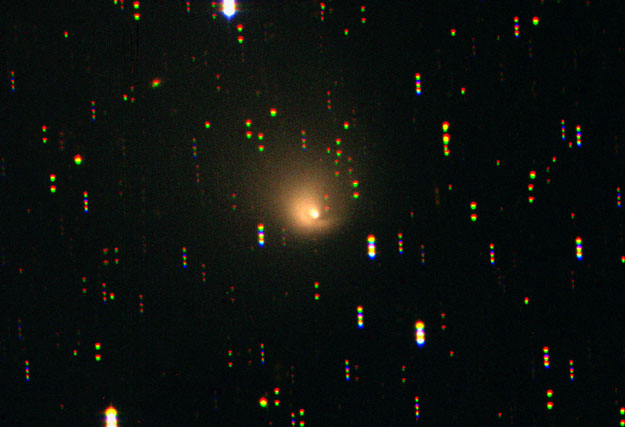
|
Credit & Copyright: Olivier Hainaut
(ESO) et al.,
MPG/ESO 2.2-m Telescope,
WFI,
La Silla Observatory,
ESO
Explanation:
Whatever became of
Comet Hale-Bopp?
The brightest
comet in recent years has continued into the outer
Solar System and is now further from the
Sun than
Saturn.
To the surprise of many,
Comet Hale-Bopp is still active,
continuing to spew gas, ice and
dust particles out into space.
Pictured above earlier this month,
Comet Hale-Bopp
can be seen in the
Southern Hemisphere
with a moderate sized-telescope.
The continued activity of
Comet Hale-Bopp
may be due to the large size of its
nucleus - estimated to be about 50 kilometers across.
The unusual dotted appearance of most stars in the
above image
is due to the 14 discrete exposures that were centered on the
comet and not the stars.
Tomorrow's picture: Cheesy Mars
|
January February March April May June July August September October November December |
| ||||||||||||||||||||||||||||||||||||||||||||||||
NASA Web Site Statements, Warnings, and Disclaimers
NASA Official: Jay Norris. Specific rights apply.
A service of: LHEA at NASA / GSFC
& Michigan Tech. U.
Based on Astronomy Picture
Of the Day
Publications with keywords: comet - Comet Hale-Bopp
Publications with words: comet - Comet Hale-Bopp
See also:
- APOD: 2025 September 30 Á Comet Lemmon Brightens
- APOD: 2025 September 29 Á Two Camera Comets in One Sky
- APOD: 2025 September 26 Á A SWAN an ATLAS and Mars
- APOD: 2025 September 18 Á Comet C/2025 R2 SWAN
- APOD: 2025 September 16 Á New Comet SWAN25B over Mexico
- APOD: 2025 July 7 Á Interstellar Comet 3I ATLAS
- Comet C/2025 F2 SWAN
